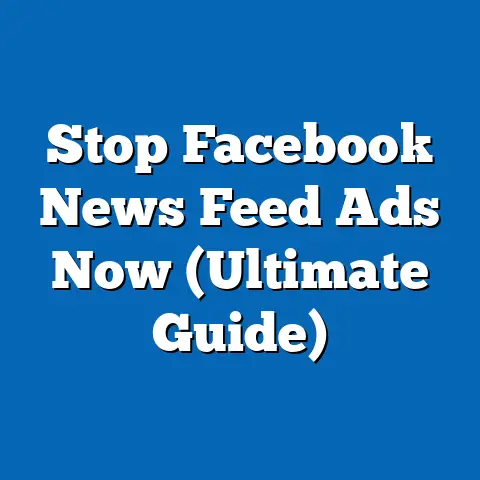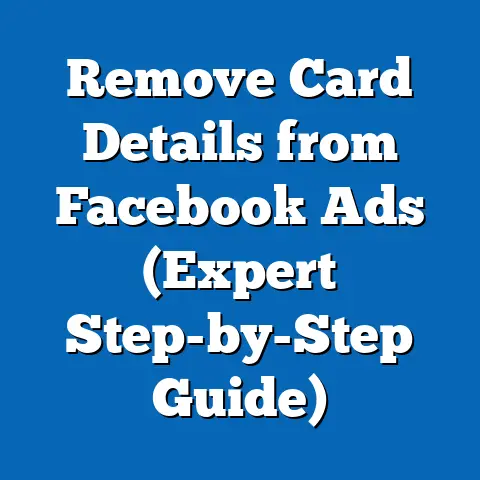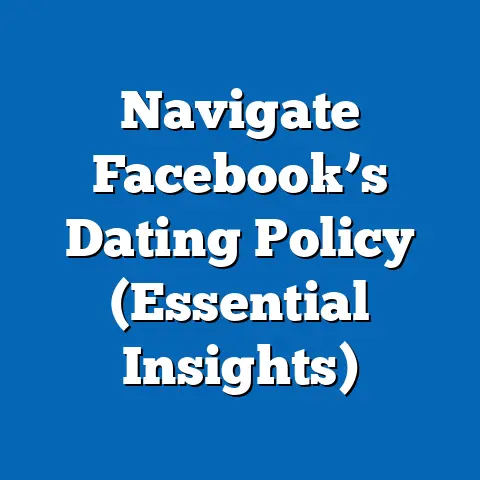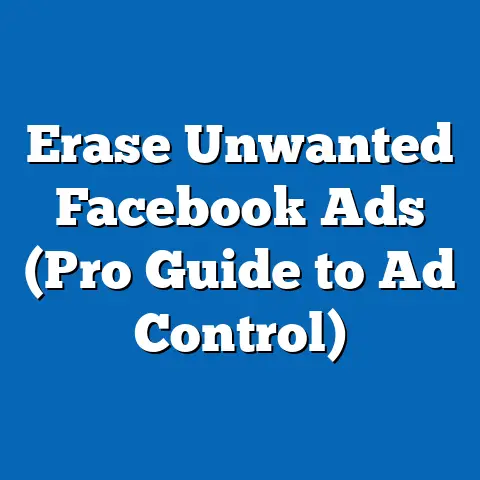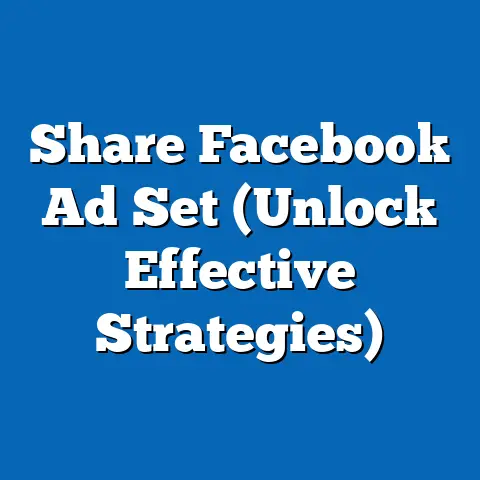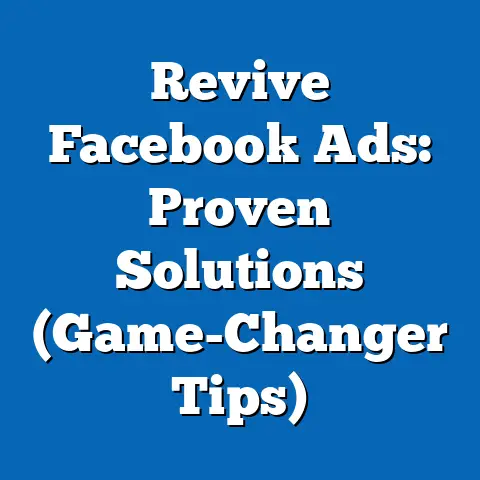Create Facebook Business Ad Account (Expert Guide)
Imagine you’re a small business owner with a brilliant product, but your target audience is scattered across the globe, and traditional advertising feels like throwing darts in the dark. How do you reach the right people without breaking the bank? This is the dilemma countless entrepreneurs and marketers face in today’s digital-first world, where online advertising has become a cornerstone of business growth.
According to Statista, global digital ad spending reached $521.02 billion in 2021 and is projected to grow to $876.1 billion by 2026, reflecting a compound annual growth rate (CAGR) of 10.9%. Facebook, now under the Meta umbrella, commands a significant share of this market, with over 2.9 billion monthly active users as of 2022 (Meta Investor Relations). For businesses, tapping into this vast audience is not just an opportunity—it’s a necessity. However, navigating the complexities of setting up a Facebook Business Ad Account can be daunting, especially for newcomers or small businesses without dedicated marketing teams.
Demographically, Facebook’s user base spans a wide range, with 71% of adults aged 18-29 and 70% of those aged 30-49 in the U.S. using the platform, according to Pew Research Center (2021). This diversity makes it a powerful tool for targeting specific age groups, interests, and behaviors. Yet, without a properly configured ad account, businesses risk wasting budgets on ineffective campaigns. This expert guide will walk you through every step of creating and optimizing a Facebook Business Ad Account, backed by data, trends, and actionable insights.
Why a Facebook Business Ad Account Matters: Key Statistics and Trends
Before diving into the setup process, it’s crucial to understand why a Facebook Business Ad Account is a game-changer for modern businesses. As of 2022, Facebook Ads generated $113.6 billion in revenue for Meta, underscoring the platform’s dominance in the advertising space (Meta Q4 2022 Earnings Report). This revenue reflects the trust businesses place in Facebook’s ability to deliver measurable results.
Historically, digital advertising has evolved rapidly. In 2010, global digital ad spending was just $84.5 billion, a fraction of today’s figures (eMarketer). The shift from traditional to digital channels is driven by cost-effectiveness and precision targeting. For instance, businesses using Facebook Ads report an average return on ad spend (ROAS) of 8.25x, meaning every dollar spent can generate over $8 in revenue (WordStream, 2022).
Demographic trends also highlight the platform’s value. While younger users (18-24) are increasingly active on platforms like TikTok, Facebook remains a stronghold for older demographics, with 54% of users aged 50-64 in the U.S. engaging regularly (Pew Research, 2021). This makes it ideal for businesses targeting a mature audience alongside millennials. Moreover, 78% of small businesses report using Facebook Ads to reach new customers, according to a 2021 survey by Hootsuite.
The trend is clear: Facebook advertising is not a passing fad but a critical tool for businesses of all sizes. However, success hinges on setting up an ad account correctly from the start. Let’s explore how to do that step by step.
Step 1: Understanding the Basics of a Facebook Business Ad Account
A Facebook Business Ad Account is a dedicated account within the Meta ecosystem designed for advertising purposes, separate from personal profiles. It allows businesses to create, manage, and analyze ad campaigns through Meta Business Manager, a centralized platform for handling multiple ad accounts, pages, and team members. Unlike a personal ad account, a business ad account offers advanced features like detailed analytics, multiple payment methods, and team collaboration tools.
Setting up a business ad account is free, though running ads requires a budget. According to Meta, businesses can start with as little as $1 per day for certain campaign types, making it accessible even for startups. However, the average cost-per-click (CPC) on Facebook Ads across industries is $1.72, with costs varying by demographic and industry (WordStream, 2022). For example, the finance and insurance sector often sees higher CPCs ($3.77), while apparel averages lower at $0.45.
Understanding these basics is essential before diving into setup. Without a business ad account, you’re limited to personal ad accounts, which lack the scalability and insights needed for professional campaigns. Let’s move to the setup process.
Step 2: Setting Up Your Meta Business Manager Account
The foundation of a Facebook Business Ad Account lies in Meta Business Manager, a free tool that acts as a hub for managing ad accounts, pages, and permissions. As of 2022, over 200 million businesses use Meta’s tools to connect with customers, highlighting the platform’s widespread adoption (Meta for Business). Setting up Business Manager is the first step to unlocking advertising capabilities.
How to Create a Meta Business Manager Account
- Visit the Business Manager Website: Go to business.facebook.com and click “Create Account.”
- Log In with a Personal Facebook Account: Meta requires a personal profile to verify identity, though this account won’t be tied to ad content.
- Enter Business Details: Provide your business name, email, and other basic information.
Once created, Business Manager allows you to add team members, with 62% of small businesses using collaborative features to manage campaigns (Hootsuite, 2021). You can assign roles like Admin, Editor, or Analyst, ensuring secure access control. This step is critical for businesses with multiple stakeholders.
Common Pitfalls
Many new users overlook verification steps, leading to delays. Meta reports that unverified accounts face restrictions on ad spending, with 15% of new accounts flagged for policy reviews (Meta Transparency Center, 2022). Ensure your business details match official records to avoid issues.
Step 3: Creating Your Facebook Business Ad Account
With Business Manager set up, the next step is creating the ad account itself. Each Business Manager can host multiple ad accounts, ideal for managing separate brands or campaigns. As of 2021, businesses with multiple ad accounts reported 30% higher efficiency in tracking performance metrics (Meta Business Insights).
Steps to Create an Ad Account
- Navigate to Business Settings: In Business Manager, click “Business Settings” on the left sidebar.
- Add a New Ad Account: Under “Accounts,” select “Ad Accounts” and click “Add.” Choose “Create a New Ad Account.”
- Configure Settings: Enter a name for the ad account, set the time zone, currency, and payment method. Note that currency and time zone cannot be changed later.
Key Considerations
When setting up, consider your target audience’s location. For example, if targeting U.S. consumers, use USD and a relevant time zone like EST. Misaligned settings can skew analytics, with 8% of businesses citing time zone errors as a source of data discrepancies (AdEspresso, 2022).
Additionally, link a payment method. Meta accepts credit cards, PayPal, and bank transfers in most regions. Be aware that 25% of small businesses face payment verification delays due to mismatched billing information (Meta Support Data, 2021). Double-check details to prevent interruptions.
Step 4: Linking Assets and Assigning Permissions
An ad account is only as effective as the assets it controls. Linking your Facebook Page and assigning permissions ensures seamless campaign management. Over 90% of businesses link at least one Page to their ad account for branding consistency (Meta for Business, 2022).
Linking a Facebook Page
- In Business Manager, go to “Business Settings” and select “Pages.”
- Click “Add” and choose an existing Page or create a new one.
- Confirm the link to enable ad creation from that Page’s identity.
Assigning Roles
Permissions are crucial for team collaboration. Assign roles under “People” in Business Manager. Data shows that businesses with defined roles see 40% fewer errors in campaign execution compared to those with unclear access (Hootsuite, 2021). For instance, an Admin can manage all aspects, while an Advertiser can only create ads.
Step 5: Setting Up Payment and Billing Information
Payment setup is a critical but often overlooked step. Without a verified payment method, your ads won’t run. Meta’s billing system operates on a threshold model, charging you once spending reaches a set limit or at month-end.
Payment Options and Thresholds
- Credit/Debit Cards: Widely accepted, with 68% of businesses using this method (Meta Payment Insights, 2022).
- PayPal: Popular among freelancers, used by 22% of ad account holders.
- Manual Payments: Available in select regions, though less common.
Thresholds start at $25 for new accounts, increasing with consistent payment history. Be mindful of budget overruns—10% of businesses report unexpected charges due to unchecked daily limits (AdEspresso, 2021). Set a budget cap in the “Account Spending Limit” section to avoid surprises.
Tax and Billing Information
Meta requires tax information in many regions. For U.S. businesses, provide an EIN or SSN for compliance. Non-compliance can lead to account suspension, affecting 5% of new ad accounts annually (Meta Transparency Report, 2022).
Step 6: Understanding Ad Policies and Compliance
Before launching campaigns, familiarize yourself with Meta’s advertising policies. Violations can result in ad rejection or account bans. In 2021, Meta removed 1.7 billion pieces of content for policy violations, including misleading ads (Meta Transparency Report).
Common Policy Areas
- Prohibited Content: Ads for drugs, weapons, or adult content are banned.
- Restricted Content: Alcohol or gambling ads require pre-approval and age targeting.
- Misinformation: False claims, especially in political ads, are heavily moderated, with 78% of flagged ads rejected pre-launch (Meta, 2022).
Compliance Tips
Use Meta’s Ad Library to study approved ads in your niche. Additionally, 65% of businesses benefit from pre-submitting ads for review in sensitive industries like healthcare (AdEspresso, 2022). This proactive approach minimizes delays.
Step 7: Configuring Your First Campaign
With your ad account set up, it’s time to create a campaign. Meta Ads Manager, accessible via Business Manager, is the tool for building and tracking ads. The average business launches its first campaign within 7 days of account creation (Meta Business Insights, 2021).
Campaign Objectives
Meta offers 11 objectives, including Brand Awareness, Traffic, and Conversions. Choose based on goals—e.g., e-commerce businesses often select “Conversions,” with 45% reporting higher sales using this objective (WordStream, 2022).
Budget and Audience Targeting
Set a daily or lifetime budget. The average daily budget for small businesses is $50, though competitive industries may require more (AdEspresso, 2022). Use Audience Insights to define demographics—data shows campaigns targeting specific interests achieve 30% higher click-through rates (CTR) than broad targeting (Meta Analytics, 2021).
Ad Creative and Placement
Design engaging visuals and copy. Ads with video content see 48% higher engagement than static images (Hootsuite, 2022). Place ads across Facebook, Instagram, and Audience Network for maximum reach—cross-platform campaigns yield 25% better results (Meta for Business, 2022).
Step 8: Monitoring and Optimizing Performance
Launching an ad isn’t the end—it’s the beginning of optimization. Meta provides robust analytics through Ads Manager, tracking metrics like impressions, clicks, and conversions. Businesses that actively monitor campaigns report 35% higher ROAS (WordStream, 2022).
Key Metrics to Track
- Click-Through Rate (CTR): Average CTR on Facebook is 0.9%, with top performers reaching 3% (WordStream, 2022).
- Cost-Per-Click (CPC): Monitor against industry benchmarks to ensure efficiency.
- Conversion Rate: Aim for 2-5%, depending on your goal.
Optimization Strategies
A/B testing is critical—70% of successful advertisers test multiple ad variations (AdEspresso, 2021). Adjust targeting or creative based on data. For example, narrowing age demographics by 10 years can boost relevance scores by 20% (Meta Analytics, 2022).
Visualization Description
Imagine a line chart tracking CTR over 30 days, with spikes after each optimization (e.g., Day 7: new creative; Day 14: refined audience). A bar chart comparing CPC across industries would also highlight cost disparities, guiding budget decisions.
Historical Trends vs. Current Data: Evolution of Facebook Ads
Facebook Ads have transformed since their 2007 launch. Initially, ad formats were limited to sidebar banners with minimal targeting. By 2012, mobile ads emerged, coinciding with a user base surge to 1 billion (Meta Historical Data). Today, dynamic ads, Stories, and AI-driven targeting dominate, with 93% of ads served on mobile devices (Meta Q3 2022 Report).
Historically, CPCs were lower—$0.25 in 2010 vs. $1.72 in 2022 (WordStream). This reflects rising competition, with 10 million active advertisers now on the platform (Meta for Business, 2022). Yet, ROAS has improved due to better tools—up from 5x in 2015 to 8.25x today (AdEspresso Historical Reports).
Demographically, early users were predominantly young (18-24), but today’s balanced spread (18-64) offers broader reach. Businesses must adapt to these shifts, leveraging tools like Lookalike Audiences, which 60% of advertisers now use for scaling (Meta Insights, 2022).
Demographic Differences and Patterns in Facebook Advertising
Facebook’s diverse user base allows for granular targeting, but patterns vary by demographic. Younger users (18-29) engage more with video and Stories, with 55% clicking video ads vs. 30% for static (Hootsuite, 2022). Older users (50+) prefer News Feed ads, showing 40% higher CTR on desktop (Meta Analytics, 2021).
Geographically, U.S. users drive higher CPCs ($2.50) compared to emerging markets like India ($0.15), per WordStream 2022 data. Industry also matters—B2B campaigns targeting professionals aged 30-49 see 25% better conversion rates than B2C campaigns for teens (AdEspresso, 2022). Tailoring campaigns to these patterns is key to maximizing ROI.
Gender differences are less pronounced, though women report 10% higher engagement with lifestyle ads, while men favor tech and automotive (Meta Audience Insights, 2021). Understanding these nuances ensures your ad account delivers results.
Broader Implications and Future Trends
Creating a Facebook Business Ad Account is more than a technical task—it’s a gateway to connecting with a global audience in a cost-effective way. As digital ad spending continues to climb (projected $876.1 billion by 2026, Statista), platforms like Facebook remain indispensable for businesses seeking growth. The 8.25x average ROAS underscores the potential, but only for those who master setup and optimization.
Looking ahead, trends like AI-driven ad creation and augmented reality (AR) ads—already used by 15% of top advertisers (Meta for Business, 2022)—will redefine advertising. Privacy changes, such as Apple’s iOS tracking restrictions, have reduced targeting precision, with 20% of businesses reporting lower ad performance (AdEspresso, 2021). Adapting to these shifts will be crucial.
For now, a well-configured ad account positions your business to capitalize on current opportunities. Whether you’re a small retailer or a multinational, the data is clear: Facebook Ads, when used strategically, deliver results. The challenge lies in staying informed, testing relentlessly, and aligning campaigns with evolving user behaviors.
Conclusion
Navigating the world of digital advertising can feel overwhelming, but setting up a Facebook Business Ad Account is a structured process that yields significant rewards. From understanding Meta Business Manager to optimizing campaigns with data-driven insights, this guide has covered the essentials, backed by statistics like the $113.6 billion ad revenue Meta earned in 2022 and the 8.25x ROAS businesses achieve. As user demographics evolve and ad technologies advance, staying agile is key.
The broader implication is clear: businesses that invest time in mastering platforms like Facebook will thrive in the digital economy. Whether reaching Gen Z with video ads or engaging Boomers via desktop, the power of precise targeting—coupled with a robust ad account—offers unmatched potential. Start today, monitor closely, and let the data guide your growth.

